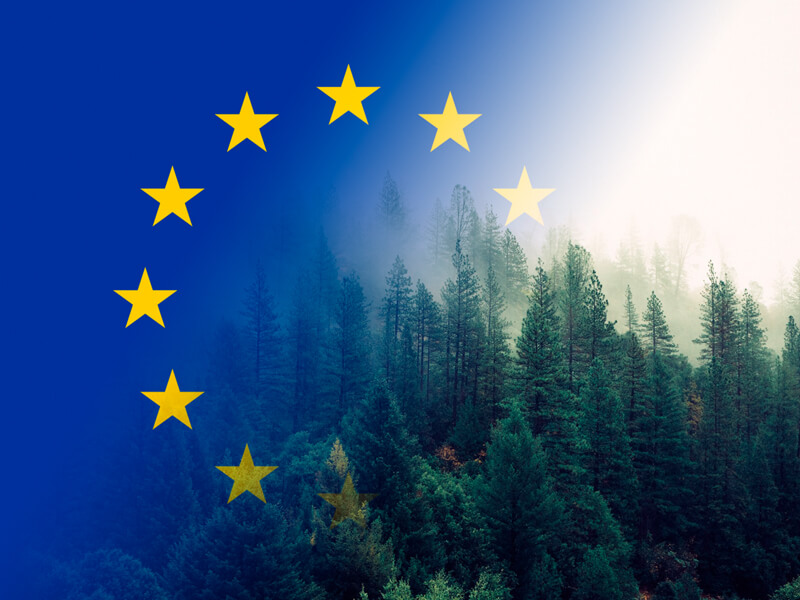One example of this is the creation of the first and largest carbon trading scheme globally. As a next step, the EU is establishing a taxonomy framework in order to promote transparency and encourage sustainability in multiple industries. The EU taxonomy creates common rules and guidelines in relation to reporting and accounting for forces that drive or reduce climate change. The intention is to counter greenwashing and to establish a common framework.
Taxonomy Sets Guidelines for Sustainable Forestry
A clear definition on the meaning of sustainability is essential in the transition towards climate neutrality. The EU plans to achieve its net zero emission goals by constructing regulatory guidelines known as the EU taxonomy. This taxonomy is a classification system that distinguishes which economic activities are environmentally sustainable. The taxonomy outlines that industries such as forestry have substantial contribution criteria to satisfy in order to achieve climate neutrality. Since January 2022, forest owners may align themselves to the taxonomy criteria by providing plans detailing how their activities will decrease the net greenhouse gas (GHG) emissions over time. Over the rest of 2022, additional environmental objectives will be introduced with the taxonomy to cover nature conservation and biodiversity criteria for sustainable practices.
New requirements for 13 hectares and above
The taxonomy regulation is divided into parts which cover different environmental objectives. The first part, covering climate change mitigation and adaption, came into effect in early 2022. For forestry, the first part details reporting requirements for complying with the taxonomy regulation. Forest owners with 13 hectares and above are encouraged to provide a forest management plan as per existing national guidelines and a climate benefit analysis. The climate benefit analysis is meant to detail how the forestry management activity in the area decreases GHG emissions over a period of 30 years, and how the long-term (from 100 years up to entire forest cycle) GHG emissions remain lower than in the absence of the forestry activity. The analysis is to be consistent with existing GHG inventory guidelines and consider carbon pools including above-ground biomass, below-ground biomass, deadwood, litter and soil with the most conservative estimates. The analysis should also include considerations for risks in the event that the projected emissions capture is disrupted.
The CollectiveCrunch Linda platform already spans over tens of millions of hectares of forests in the Nordics and Baltics and provides verifiably more accurate results than field visits. Using a smart combination of remote sensing, big data and AI, our solution offers high-resolution forest models that can be adapted for taxonomy verification. We can help you with precise forest inventories and predictions, as well as ensure the validity of the results for required audits from national authorities or independent third-party certifiers.
The Demand for Sustainable Forestry
The reporting rules described above are not mandatory. This raises the question: Why should forest owners care?
Forest owners generally sell their inventories at maturity to larger firms that harvest and turn the raw material into products. Such large firms are required by law to report their own climate performance under the taxonomy regime. In order to do so, these purchasers of timber require proof of climate performance from their suppliers. We expect this mandatory reporting requirement towards large firms to lead to a requirement of forest owners above 13 ha to provide such taxonomy reporting and we expect large purchasers of timber to pay a premium for such certified timber.
With the requirement to be transparent, large companies operating in the European region will have an increasing demand for taxonomy compliant forest products as it allows them to report the sourced wood as sustainable. Due to the taxonomy transparency, existing certifiers such as the FSC and PEFC are likely to adopt taxonomy criteria as part of the requirements for sustainable certification in the European region. We believe that the EU is open to include existing FSC and PEFC regimes under its taxonomy regime. This way the stage is set for more unified standards between certifiers to strengthen sustainability credibility and diminish venues for greenwashing.
Taxonomy compliance for small forest owners implies additional bureaucracy at a first glance. For existing certification standards, common choice for smaller forest owners is participation through group certification. The taxonomy allows similar grouping for holdings that are sufficiently homogeneous and that the group remains the same through subsequent audits. As many of the prerequisites for taxonomy compliance share similarities between existing certification standards, the transition is less cumbersome for forest owners already holding sustainability certifications. Additionally, we expect that the taxonomy will increase the likelihood of currently uncertified forest owners to become certified due to the shift from voluntary certifications to legislation backed frameworks. If the future trend for companies is to operate with 100% sustainable practices then any demand for forestry products without such certification will cease to exist.
CollectiveCrunch provides world-class analytics for tens of millions of hectares of forests with unprecedented accuracy. Stay tuned with our latest updates by subscribing to our newsletter or contact us for more information.
Glossary of Terms
EU Taxonomy
Classification system that provides definitions for environmentally sustainable economic activities.
Greenwashing
Misleading the public to present goals, products or policies as more environmentally friendly than they are in reality.




